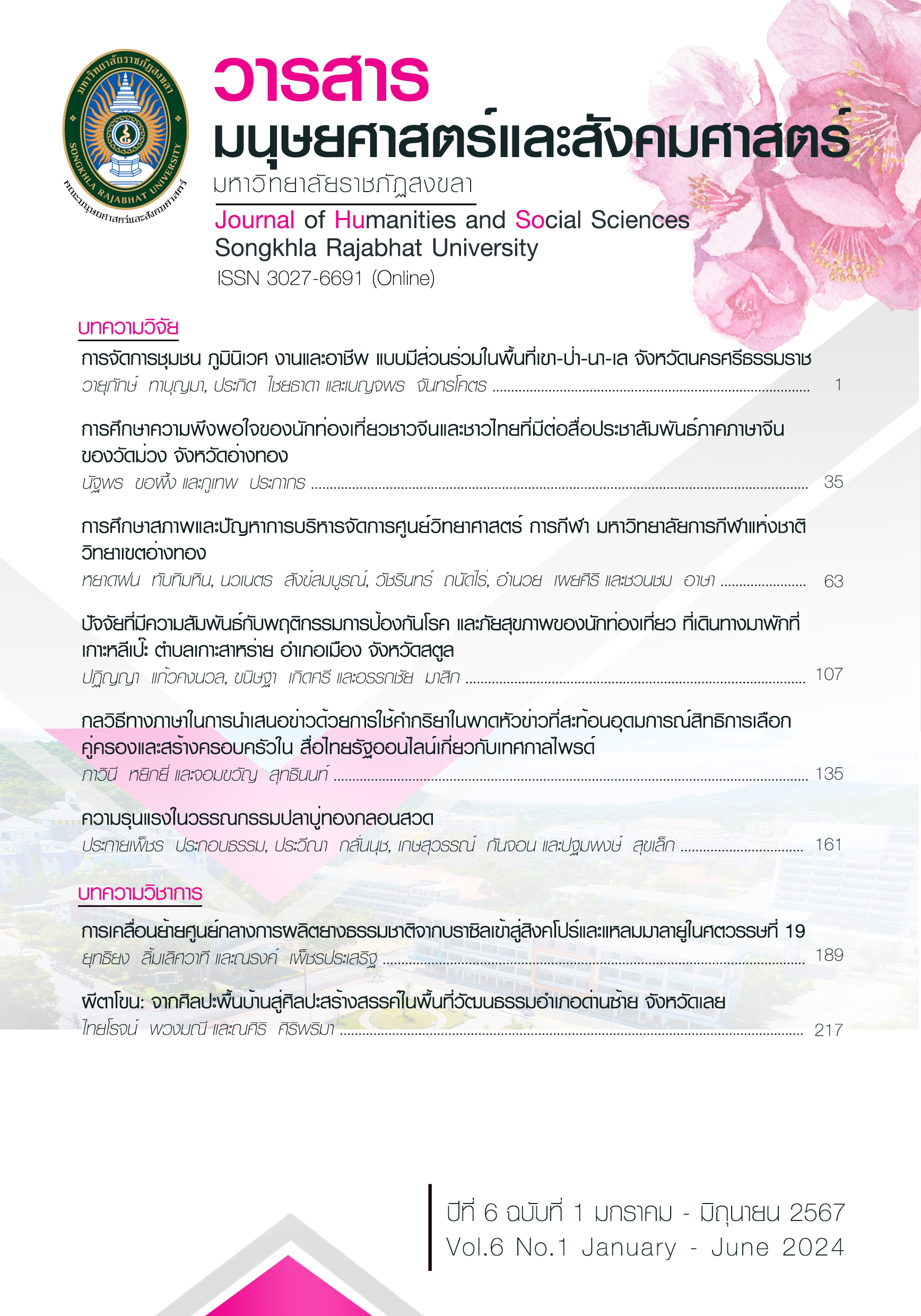PHI TA KHON: FROM FOLK ARTS TO THE CREATIVE ARTS IN DAN SAI DISTRICT'S CULTURAL AREA, LOEI PROVINCE
Main Article Content
Abstract
This article aimed to study the transformation of Phi Ta Khon from folk art to creative art in Dan Sai District’s cultural area, Loei Province. The study revealed that Phi Ta Knon, formerly known as Phi Tam Khon (ghost following people), was a part of Bun Luang, a Buddhist merit-making holiday. The Phi Ta Khon ascribed a story to when Phra Vessantara decided to go back to the town. However, the forest spirits who used to serve him were sad and nostalgic. Forest spirits, therefore, disguised themselves with the villagers to send Phra Vessantara along with the parades and processions through the town. They had found something that could be used to conceal one's face so as not to frighten those who saw it. Originally, Phi Ta Khon's ghostly mask and costume were made with accessible materials that were easy to find in the community. Nowadays, Phi Ta Khon is changed into a new style that creates a sense of grandeur and splendor by using modern materials with modern patterns, colors, and techniques for blending. The Phi Ta Khon-making concept is clearly defined, so the image of Phi Ta Khon becomes more fantasy. The factors that caused the change in Phi Ta Khon were more creative artistic skills in the community, art and cultural tourism management trends, advanced design technology, tourists’ behavior toward arts and culture recognition, drawing and coloring contests, and the continuously driving tourism activities by the government sector.
Downloads
Article Details

This work is licensed under a Creative Commons Attribution-NonCommercial-NoDerivatives 4.0 International License.
ลิขสิทธิ
References
เขมา แฉ่งฉายา. (2565). ผลการสร้างสรรค์ศิลปะร่วมสมัยจากการศึกษาภูมิปัญญาการใช้รูปทรงในภาพจิตรกรรมฝาผนัง (วัดเกาะ) สกุลช่างเมืองเพชร. มนุษย์สังคมปริทัศน์. 24(1), 135-146.
ชาลินี บริราช. (2563). อำเภอด่านซ้าย จังหวัดเลย เทศกาลผีตาโขน: ผีไทยที่ดังไกลถึงเวทีโลก. สืบค้นเมื่อ 30 สิงหาคม 2566, จาก https://www.creativethailand.org/view/article
ไทยโพสต์. (2566). สีสันแห่งความสนุกงานประเพณีแห่ผีตาโขน 2566. สืบค้นเมื่อ 30 สิงหาคม 2566, จากhttps://www.thaipost.net/tac/travel-news/389944
ธีรภัทร คำทิ้ง และภาคภูมิ สุขเจริญ. (2564). ประเพณีบุญหลวงและการละเล่นผีตาโขน อำเภอด่านซ้าย จังหวัดเลย: บทบาทหน้าที่ในสถานะประเพณีประดิษฐ์ภายใต้สถานการณ์โรคโควิด-19. มหาวิทยาลัยหอการค้าไทย. 41(1), 21-36.
นพพล แก่งจำปา. (2562). ท่องเที่ยวเทศกาลผีตาโขน: การเดินทางของผีชายขอบสู่โลกกว้างและการสร้างพื้นที่ทางสังคมของชาวด่านซ้ายในบริบทของอุตสาหกรรมการท่องเที่ยว. อารยธรรมศึกษาโขง-สาละวิน. 10(2), 169-193.
ปฐม หงส์สุวรรณ. (2558). “วิธีคิดท้องถิ่นกับการสร้างความเป็นพระโพธิสัตว์ชาวบ้านในประเพณีบุญหลวง อำเภอด่านซ้าย จังหวัดเลย”. มนุษยศาสตร์และสังคมศาสตร์. 6(1), 1-32.
ปรีชา เถาทอง. (2561). “ศิลปะสร้างสรรค์องค์ความรู้ทางวิชาการ”. บริหารธุรกิจและสังคมศาสตร์. 1(2), 22-39.
พรพิทักษ์ แม้นศิริ. (2564). ประเพณีผีตาโขน: รูปแบบการสืบสานมรดก ภูมิปัญญาทางวัฒนธรรมสองแผ่นดินไทย-ลาว. [วิทยานิพนธ์ปริญญาปรัชญาดุษฎีบัณฑิต]. มหาวิทยาลัยมหาสารคาม. สืบค้นเมื่อ 16 กรกฎาคม 2566, จาก http://202.28.34.124/dspace/handle/123456789/1389
พระครูปลัดสุรวุฒิ แสงมะโน, แสงอาทิตย์ ไทยมิตร, อัครเดช นีละโยธิน และอัจฉรา สาธุ. (2562). ผีตาโขน: พุทธศรัทธาในรูปแบบของวัฒนธรรมพื้นบ้าน. วิทยาลัยสงฆ์นครลำปาง. 8(2), 214-225.
สุทธินันท์ ศรีอ่อน. (2565). จินตนาการหน้ากากผีในวัฒนธรรมพุทธสองฝั่งโขง. วิวิธวรรณสาร. 6(3), 87-104.
อธิวุธ งามนิสัย. (2561). การประยุกต์ศิลปะพื้นบ้านสู่ผลงานทัศนศิลป์ออกแบบผลิตภัณฑ์ของที่ระลึกจากอัตลักษณ์ศิลปะพื้นบ้านสำหรับนักท่องเที่ยว. คณะสถาปัตยกรรมศาสตร์. 23(23), 115-129.
เอกรินทร์ พึ่งประชา. (2557). ผีตาโขน: นิยามและความหมายเบื้องหลังหน้ากากผีตาโขน. ดำรงวิชาการ. 4(1), 120-129.
Talknewsonline. (2565). เลยคึกคักนักท่องเที่ยวร่วมงานวันไหลผีตาโขนบ้านนาเวียง อำเภอด่านซ้าย. สืบค้นเมื่อ 25 สิงหาคม 2566, จาก https://www.talknewsonline.com/476740/


